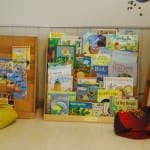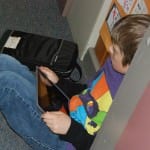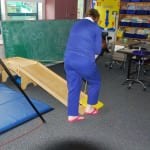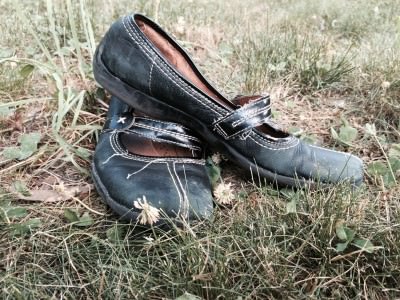My mentor and colleague, Ran Coble, taught me that you can visit a place or you can take the time to get to know a place. So when I travel, I interview locals, visit schools, go to school board meetings, read the local newspaper, listen to talk radio, etc.


Earlier this summer, I spent a week in Bar Harbor, Maine. You can’t walk down Main Street without figuring out very quickly that it is pronounced “Bah Hahbah.” This town is situated on Mount Desert Island, in what is known as “Down East” Maine, and it has a population of about 5,200 year-round residents. The island has an area of 108 square miles, and it is known for its lobster and Acadia National Park.
Nine schools comprise the Mount Desert Island Regional School System, including a K-8 school in Bar Harbor called the Conners Emerson School. The principal is Barbara Neilly. She has been the principal here for 23 years.
She refers to herself as a “summer brat.” Her family grew up camping in a tent on the island during the summers.
When you walk into Conners Emerson School, the overwhelming feeling is that it is comfortable in a way schools just aren’t anymore. The school is about 60 years old, and the people are comfortable, the classrooms are comfortable, the students are comfortable.
When I ask the receptionist to track down the principal for me, she says, “I’ll see if I can find the girl.” I notice a sign in her office that says, “Beware of attack secretary.” Like I said, it is comfortable. People are at ease. And out of that comfortable space, a really rich learning environment emerges.
This school feels old school
The classrooms here are classic. They are big, and they are bright. I realize how much I miss a kindergarten class with a kitchen, doll babies, a sand tray, a reading corner, and a work shop. Nap time, too. And no devices…at least not in kindergarten.
That changes as the children grow up. First and second graders are taught to code and iPads are used in grades 3-8. There is a green room, 3D printers, and, my favorite, a computer museum.
This school challenges me to rethink my own preconceptions of a 21st century learning environment. It is a lovely juxtaposition of old and new learning strategies.
Small school, small classes
Neilly, the principal, has worked in high schools, 7-12 schools, and K-8 schools. She likes the K-8 model, but in part, it is because her school has a lot of space. She has K-4 in one building and grades 5-8 in another. But even in the building for older students, she has enough room to have a 5th/6th grade wing and a 7th/8th grade wing.
The K-8 model, she says, “is great for the adults because you can see how the students progress, keeping a pulse on each student.” It’s like a family. “We know where each kid needs to be at the end of each span – K-2, 3-5, and 6-8.”
According to the N.C. Department of Public Instruction, just 76 of our 2,643 schools are K-8.
At Conners Emerson, with just 372 students, Neilly’s classes are small – about 12-17 students in each class.


Students swirl in and out of this school. The seasonal nature of Bar Harbor means that some students live in other states like Florida during the winter, and she has them for spring and fall. There are two scientific laboratories on the island – The Jackson Laboratory and the MDI Biological Laboratory – and students accompany their parents here to work. The students speak 10 different languages, including Filipino, Indian, Japanese, German, Chinese, and Dutch. The small class size allows Neilly to integrate the kids easily.


This student is from the Czech Republic, and her parent works at The Jackson Laboratory. The principal says, “I love the way she rolls her Rs.”
These labs work with the schools to provide curriculum extensions for the students. In 4th grade, for example, refrigerated tanks are brought in to raise salmon fry, which the students later release in the wild.
The whole child
The K-8 model allows for a lot of project-based learning and service learning, says Neilly. There is a strong focus on the arts and music.
This is the art room. It is beyond fabulous, stocked with supplies.


Students in 2nd grade learn violin, in 3rd grade tin whistles, in 4th grade the ukulele, in 5th grade they make dulcimers, and in 6th grade keyboard. In 7th and 8th grades, they learn to DJ, music engineering, African drumming, and the list goes on and on. Neilly says, “They like it a whole lot more than a general music program.” The school owns lots of instruments and the Jazz Band historically is the best in the state for the size of the school. The music program has its own website.
Here is the Jazz Band at the state festival:
School health
One of the things that caught my eye as I was researching which schools I wanted to visit on my trip was on this school’s website there is a nurse’s corner. There is a school nurse and a school physician. The physician spends three days each school year on campus, and students in the 3rd and 6th grades get physical exams.


This is Nurse Betty. The school nurse manages students with high medical needs. One student has a life-threatening shellfish allergy. She checks blood levels, administers medication, monitors asthmatics, addresses lyme disease caused by ticks in the area, and tends to students with other chronic health conditions. At nearby schools in this district, where the school nurse is a family nurse practitioner, they are able to write prescriptions as well.
This classroom is designed for students with ADHD (attention deficit hyperactivity disorder). When the students’ senses get overloaded in class, they come here for sensory integration.
The principal explains proprioceptive sensory feedback to me. The deep pressure provided by these activities triggers a response in the brain allowing the students to get grounded again before returning to the classroom.
Part of the Maine philosophy towards educating students is to keep them healthy – mind and body.
Funding
The principal spends about $11,000 per pupil, and 95 percent of those dollars come from the local government. In October, Neilly presents her budget for the next year to the school board. The school board adopts a budget by year end, December 31. The budget then goes to the town council, which reviews it and makes recommendations. The budget is then reviewed by the “warrant committee,” 22 members of the community that are responsible for the town’s budget and making sure dollars are spend wisely. From the warrant committee, the budget is presented to the public at large in a town hall meeting. Neilly says that if the town council and the warrant committee unanimously recommend the budget, then the town vote usually goes well.
Other factors
Conners Emerson gets a school grade of B from the Maine State Department of Education. Here you can see the report card.
Neilly says,
“Our philosophy is to meet the kids where they are and take them to where they need to be.”
She uses the Stepping Stones curriculum from Australia for math in grades K-5. She uses EngageNY for the math curriculum in grades 6-8. Neilly has a full-time math interventionist for grades K-4.
“We’re doing Common Core,” she says. She likes its rigor, the continuums, and the proficency-based learning. But for her most advanced math students, she is using a blended model that allows her to teach algebra and geometry. “When things work in a community, ” her advice is to “keep it.”
Older students are in math for 70 minutes each day and ELA (English Language Arts) for 70 minutes each day. In earlier grades, students that need reading remediation are pulled out of class for reading recovery, a program that provides a 1:1 teacher/student ratio for 40 minutes a day for 18 weeks.
This school is predominantly white and just 17 percent of the kids receive free and reduced price lunch. The attendance rate is more than 94 percent.
An entry level teacher with a Bachelor’s degree will make $34,055. The salary schedule caps out at $63,353.
But Neilly covers 85 percent of the cost of each staff’s family insurance plan – at a cost of about $20,000 per staff person each year.
She has a stable teaching staff and about 60 percent are from within a 60 mile radius.
It helps, she says, that “by and large, people are fairly satisfied with public schools.”
If you are in Bar Harbor…
The best lobster roll and lobster quesadillas can be found at Side Street Cafe.
Ben and Bill’s Chocolate Emporium is where you can find lobster ice cream.
Don’t miss The Travelin Lobster at 864 State Highway 3, a great lobster shack.






























